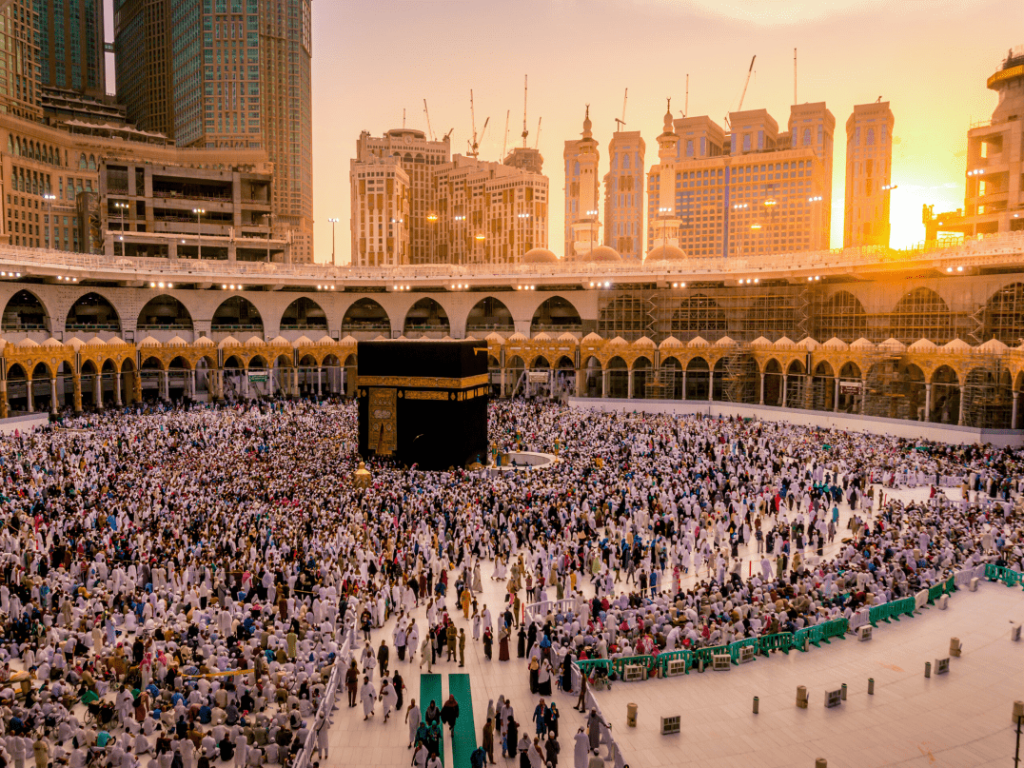The Hajj is more than just a trip; it’s a profound spiritual journey and a fundamental practice for Muslims worldwide. As one of the Five Pillars of Islam, the pilgrimage to mecca is a religious duty that every Muslim must perform at least once in their lifetime if they are physically and financially able. It is a powerful display of faith, unity, and submission to God.
This guide will take you through the history, rituals, and significance of the Hajj, answering key questions like Why is Hajj important? and How Do You Prepare For Hajj?
History and Purpose of Hajj
The History of Hajj dates back to the time of Prophet Ibrahim (Abraham). Muslims believe that the rituals of Hajj re-enact the acts of devotion performed by Ibrahim, his wife Hagar, and their son Ishmael. Prophet Muhammad later established the current form of the pilgrimage in 632 CE.
The purpose of Hajj is to fulfill a spiritual duty to God and to seek forgiveness for past sins. It’s an opportunity for Muslims to cleanse their souls and start anew, believing that a sincere and accepted Hajj (a Mabroor Hajj) is rewarded with paradise.
Differences Between Hajj and Umrah
While both are pilgrimages to Mecca, the differences between Hajj and Umrah are key.
- Hajj is a greater pilgrimage and a compulsory act of worship for every capable Muslim. It takes place at a specific time of year, from the 8th to the 13th of the Islamic month of Dhul-Hijjah. The rites are extensive and take several days to complete.
- Umrah, often called the “minor pilgrimage,” is a voluntary act of worship that can be performed at any time of the year. The umrah rituals for muslim pilgrims are shorter and can be completed in a few hours.
Rites of Hajj: A Day-by-Day Guide
The Rites of Hajj are a series of symbolic actions that pilgrims perform over five to six days, each carrying deep spiritual significance.
Entering Ihram
Pilgrims begin the pilgrimage by entering a sacred state of spiritual purity known as Ihram. This state involves not only wearing specific clothing—two simple, seamless white cloths for men and modest, loose-fitting garments for women—but also adhering to a strict set of prohibitions. These include avoiding perfume, refraining from cutting hair or nails, and abstaining from arguments or ill temper. This uniform state symbolizes equality and humility before God.
Day 1 & 2: Mina and Arafat
- First Day of Hajj (8th of Dhul-Hijjah): Pilgrims travel to the valley of Mina, a large tent city, where they renew their intention for Hajj. They spend the day in prayer and spiritual reflection, preparing themselves mentally and spiritually for the intense rituals to come.
- Second Day of Hajj (9th of Dhul-Hijjah): This is the most important day of the pilgrimage. Pilgrims travel to Mount Arafat , where they spend the afternoon in a ritual called wuquf (standing). This is a time of intense prayer and reflection, symbolizing standing before God on the Day of Judgment. After sunset, pilgrims travel to Muzdalifah, where they spend the night under the open sky and collect pebbles for the next day’s ritual.
Day 3: The Day of Sacrifice
This day marks the beginning of Eid al-Adha and is the busiest for pilgrims. The day’s rituals include:
- Ramy al-Jamarat: Pilgrims perform a symbolic stoning of the devil by throwing seven pebbles at the largest of three pillars. This ritual re-enacts Prophet Ibrahim’s defiance of Satan’s temptations.
- Animal Sacrificing: Pilgrims perform an animal sacrifice (known as Qurbani) or make a symbolic payment. This ritual commemorates Prophet Ibrahim’s willingness to sacrifice his son.
- Hair Removal: Men shave their heads, and women cut a small lock of their hair. This symbolizes a fresh start, the shedding of sins, and a release from the burdens of the past.
- Tawaf Ziyarat/Ifadah: Pilgrims travel to Mecca to perform Tawaf Ziyarat/Ifadah, a circumambulation of the Kaaba, which is considered the primary Tawaf of Hajj.
Days 4 & 5 & Farewell Tawaf
- Fourth and Fifth Day of Hajj (11th and 12th of Dhul-Hijjah): Pilgrims return to Mina to repeat the stoning ritual. They throw seven pebbles at each of the three pillars every day, continuing the symbolic rejection of evil.
- Tawaf al-Wadaa (Farewell): The pilgrimage concludes with the Tawaf al-Wadaa (the Farewell Circumambulation) of the Kaaba. Pilgrims perform this final Tawaf as a last act of worship before leaving Mecca, a deeply emotional and spiritual end to their journey.
The Foundations of Hajj and Islam
Hajj is one of the fundamental practices and institutions of Islam, known as the Five Pillars. These pillars are the core acts of worship that define a Muslim’s life.
- The shahādah: The profession of faith, declaring that there is no god but God, and Muhammad is His Messenger.
- Prayer: Ṣalāt, the five daily prayers.
- The zakāt: The giving of charity to the poor and needy.
- Fasting: Ṣawm, fasting during the month of Ramadan.
- The hajj: The pilgrimage to Mecca.
The Economic and Social Impact
The Arrangement and facilities for the millions of pilgrims who visit Mecca each year are a massive undertaking. The Number of pilgrims per year can reach over 2.5 million, requiring extensive infrastructure. This has a significant impact on the country’s economy, with Hajj and the Saudi economy generating billions of dollars annually.
Beyond the economic impact, Hajj is a powerful social institution, uniting Muslims from all over the world in a single act of worship, reinforcing their shared faith and equality.
Whether you’re preparing for the pilgrimage or simply wish to understand its importance, the Hajj is a spiritual journey of immense depth and beauty. For anyone interested in learning the language behind these sacred practices, a tool like the Kaleela app can help you connect with the rich spiritual and cultural heritage of Islam.



